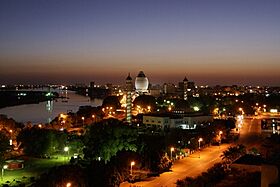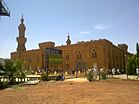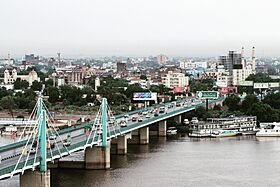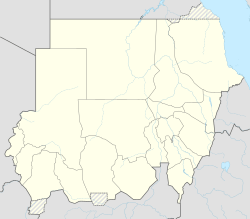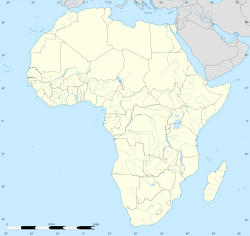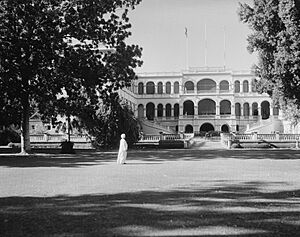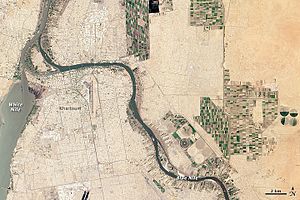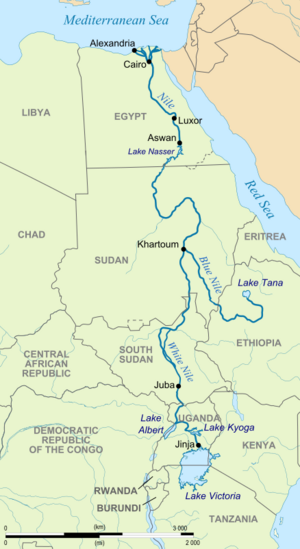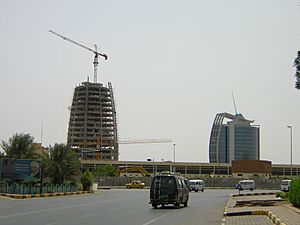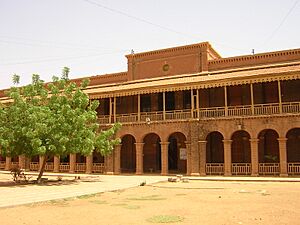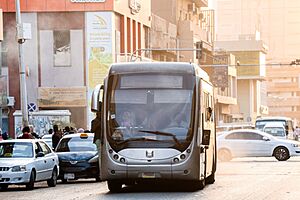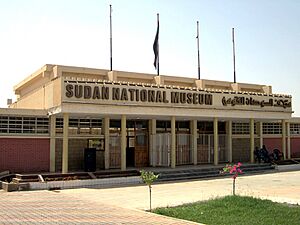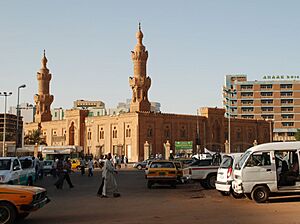Khartoum facts for kids
Quick facts for kids
Khartoum
الخرطوم
|
||
|---|---|---|
|
From top: night view of Khartoum, Khartoum Mosque, the University of Khartoum, and the El Mek Nimr Bridge.
|
||
|
||
| Nickname(s):
"Triangular Capital"
|
||
| Country | ||
| State | Khartoum | |
| Area | ||
| • Capital city | 1,010 km2 (390 sq mi) | |
| Elevation | 381 m (1,250 ft) | |
| Population
(urban 2021, all others 2013)
|
||
| • Capital city | 639,598 | |
| • Urban | 6,017,000 | |
| • Metro | 6,344,348 | |
| Demonyms | Khartoumese, Khartoumian (the latter more properly designates a Mesolithic archaeological stratum) | |
| Time zone | UTC+02:00 (Central Africa Time) | |
| • Summer (DST) | (Not Observed) | |
Khartoum or Khartum (![]() i/kɑːrˈtuːm/ KAR-toom; Arabic: الخرطوم, romanized: al-Khurṭūm, pronounced [al.xur.tˤuːm]) is the capital of Sudan. With a population of 6,344,348, Khartoum's metropolitan area is the largest in Sudan.
i/kɑːrˈtuːm/ KAR-toom; Arabic: الخرطوم, romanized: al-Khurṭūm, pronounced [al.xur.tˤuːm]) is the capital of Sudan. With a population of 6,344,348, Khartoum's metropolitan area is the largest in Sudan.
Khartoum is located at the confluence of the White Nile – flowing north from Lake Victoria – and the Blue Nile, flowing west from Lake Tana in Ethiopia. Divided by these two parts of the Nile, the Khartoum metropolitan area is a tripartite metropolis consisting of Khartoum proper and linked by bridges to Khartoum North (الخرطوم بحري al-Kharṭūm Baḥrī) and Omdurman (أم درمان Umm Durmān) to the west. The place where the two Niles meet is known as al-Mogran or al-Muqran (المقرن; English: "The Confluence").
Khartoum was founded in 1821 by Muhammad Ali Pasha, north of the ancient city of Soba. In 1882 the British Empire took control of the Egyptian government, leaving the administration of Sudan in the hands of the Egyptians. At the outbreak of the Mahdist War, the British attempted to evacuate Anglo-Egyptian garrisons from Sudan but the Siege of Khartoum in 1884 resulted in the capture of the city by Mahdist forces and a massacre of the defending Anglo-Egyptian garrison. In 1898 it was reoccupied by British forces and was the seat of Anglo-Egyptian Sudan's government until 1956.
In 1956, the city was designated as the capital of an independent Sudan.
In 2008, the Justice and Equality Movement engaged in combat in the city with the Sudanese Armed Forces as part of the War in Darfur. The Khartoum massacre occurred in 2019 during the Sudanese Revolution. The city saw extensive combat during the 2023 Sudan conflict between the armed forces and the Rapid Support Forces (RSF), affecting Khartoum International Airport and other critical sites.
Khartoum is an economic and trade center in North Africa, with rail lines from Port Sudan and El-Obeid. It is served by Khartoum International Airport with the New Khartoum International Airport under construction. Several national and cultural institutions are in Khartoum and its metropolitan area, including the National Museum of Sudan, the Khalifa House Museum, the University of Khartoum, and the Sudan University of Science and Technology.
Contents
Etymology
The origin of the word Khartoum is uncertain. Scholars posit that the name derives from the Dinka words khar-tuom (Dinka-Bor dialect) or khier-tuom (as is the pronunciation in various Dinka dialects), translating to "place where rivers meet". This is supported by historical accounts which place the Dinka homeland in central Sudan (around present-day Khartoum) as recently as the 13th-17th centuries A.D.
One folk etymology is that it is derived from Arabic khurṭūm (خرطوم 'trunk' or 'hose'), probably referring to the narrow strip of land extending between the Blue and White Niles.
Captain J.A. Grant, who reached Khartoum in 1863 with Captain Speke's expedition, thought the name was most probably from the Arabic qurtum (قرطم 'safflower', i.e., Carthamus tinctorius), which was cultivated extensively in Egypt for its oil to be used as fuel. Some scholars speculate that the word derives from the Nubian word Agartum, meaning "the abode of Atum", Atum being the Nubian and Egyptian god of creation. Other Beja scholars suggest Khartoum is derived from the Beja word hartoom, "meeting". Sociologist Vincent J. Donovan notes that in the Nilotic Maa language of the Maasai people, khartoum means "we have acquired" and that the geographical location of Khartoum is where Maasai oral tradition claims that the ancestors of the Maasai first acquired cattle.
History
19th century

In 1821, Khartoum was established 15 mi (24 km) north of the ancient city of Soba, by Ismail Kamil Pasha, the third son of Egypt's ruler, Muhammad Ali Pasha, who had just incorporated Sudan into his realm. Originally, Khartoum served as an outpost for the Egyptian Army, but the settlement quickly grew into a regional center of trade. It also became a focal point for the slave trade. Later, it became the administrative center and official capital of Sudan.
On 13 March 1884, troops loyal to the Mahdi Muhammad Ahmad started the siege of Khartoum, against occupying British led by General Charles George Gordon. The siege ended in a massacre of the Anglo-Egyptian garrison when on 26 January 1885 the heavily damaged city fell to the Mahdists.
On 2 September 1898, neighboring Omdurman was the scene of the bloody Battle of Omdurman, during which British forces under Herbert Kitchener defeated the Mahdist forces defending the city.
20th century
During World War II, the Italian Empire attempted to advance into Sudan from Ethiopia, with the end goal of capturing Khartoum. However, the Italian attack was repelled by British forces in Sudan.
The fourth Arab League summit was held in Khartoum on 29 August 1967.
In 1973, the city was the site of a hostage crisis in which members of Black September held 10 hostages at the Saudi Arabian embassy, five of them diplomats. The US ambassador, the US deputy ambassador, and the Belgian chargé d'affaires were murdered. The remaining hostages were released. A 1973 United States Department of State document, declassified in 2006, concluded: "The Khartoum operation was planned and carried out with the full knowledge and personal approval of Yasser Arafat."
In 1977, the first oil pipeline between Khartoum and Port Sudan was completed.
The Organization of African Unity summit of 18–22 July 1978 was held in Khartoum, during which Sudan was awarded the OAU presidency.
Throughout the 1970s and 1980s, Khartoum was the destination of hundreds of thousands of refugees fleeing conflicts in neighboring nations such as Chad, Eritrea, Ethiopia and Uganda. Many Eritrean and Ethiopian refugees assimilated into society, while others settled in large slums on the city's outskirts. Since the mid-1980s, large numbers of refugees from South Sudan and Darfur – fleeing the violence of the Second Sudanese Civil War and Darfur conflict – have settled around Khartoum.
In 1991, Osama bin Laden purchased a house in the affluent al-Riyadh neighborhood of the city and another in Soba. He lived there until 1996, when he was banished from the country. Following the 1998 U.S. embassy bombings, the United States accused bin Laden's al-Qaeda group and, on 20 August, launched cruise missile attacks on the al-Shifa pharmaceutical factory in Khartoum North. The factory's destruction created diplomatic tension between the U.S. and Sudan. The factory ruins are now a tourist attraction.
In November 1991, the government of President Omar al-Bashir sought to remove half the population from the city. The residents, deemed squatters, were mostly southern Sudanese whom the government feared could be potential rebel sympathizers. Around 425,000 people were placed in five "Peace Camps" in the desert an hour's drive from Khartoum. The camps were watched over by heavily armed security guards, many relief agencies were banned from assisting, and "the nearest food was at a market four miles away, a vast journey in the desert heat." Many residents were reduced to having only burlap sacks as housing. The intentional displacement was part of a large urban renewal plan backed by the housing minister, Sharaf Bannaga.
21st century
The sudden death of SPLA head and vice-president of Sudan John Garang in late July 2005, was followed by three days of violent riots in the capital. Order was finally restored after southern Sudanese politicians and tribal leaders sent strong messages to the rioters. The death toll was at least 24, as youths from southern Sudan attacked northern Sudanese and clashed with security forces.
The African Union summit of 16–24 January 2006 was held in Khartoum; as was the Arab League summit of 28–29 March 2006, during which they elected Sudan the Arab League presidency.
On 10 May 2008, the Darfur rebel group Justice and Equality Movement attacked the city with the goal of toppling Omar al-Bashir's government. The Sudanese government held off the assault.
On 26 October 2021, the city was locked down following a military coup that left at least 7 dead, triggering protests and calls for a general strike. Prime minister Abdalla Hamdok was arrested during the coup, and held along with other cabinet members in an unknown location.
On 15 April 2023, fighting between the Sudanese Armed Forces and the RSF broke out across Sudan, including in Khartoum. Fighting was reported at the presidential palace, the RSF's headquarters, Khartoum International Airport and Merowe Airport, the last two of which the RSF claimed to have captured. Gunfire and clashes were also reported at El Obeid Airport in North Kordofan.
Geography
Location
Khartoum is located at the confluence of the Blue Nile and the White Nile.
Khartoum is relatively flat, at elevation 385 m (1,263 ft), as the Nile flows northeast past Omdurman to Shendi, at elevation 364 m (1,194 ft) about 163 km (101 mi) away.
Climate
Khartoum features a hot desert climate (Köppen climate classification BWh) with a dry season occurring during winter, typical of the Saharo-Sahelian zone, which marks the progressive passage between the Sahara Desert's vast arid areas and the Sahel's vast semi-arid areas. The climate is extremely dry for most of the year, with about eight months when average rainfall is lower than 5 mm (0.20 in). The very long dry season is itself divided into a warm, very dry season between November and February, as well as a very hot, dry season between March and May. During this part of the year, hot, dry continental trade winds from deserts, such as the harmattan, sweep over the region; the weather is stable and very dry.
The very irregular, very brief, rainy season lasts about 1 month as the maximum rainfall is recorded in August, with about 48 mm (1.9 in). The rainy season is characterized by a seasonal reverse of wind regimes, when the Intertropical Convergence Zone goes northerly. Average annual rainfall is very low, with only 121.3 mm (4.78 in) of precipitation. Khartoum records on average six days with 10 mm (0.39 in) or more and 19 days with 1 mm (0.039 in) or more of rainfall. The highest temperatures occur during two periods in the year: the first at the late dry season, when average high temperatures consistently exceed 40 °C (104 °F) from April to June, and the second at the early dry season, when average high temperatures exceed 39 °C (102 °F) in September and October. Temperatures cool off somewhat during the night, with Khartoum's lowest average low temperature of the year, in January, just above 15 °C (59 °F). Khartoum is one of the hottest major cities on Earth, with annual mean temperatures hovering around 30 °C (86 °F). The city also has very warm winters. In no month does the average monthly high temperature fall below 30 °C (86 °F). This is something not seen in other major cities with hot desert climates, such as Riyadh, Baghdad and Phoenix.
| Climate data for Khartoum (1991–2020) | |||||||||||||
|---|---|---|---|---|---|---|---|---|---|---|---|---|---|
| Month | Jan | Feb | Mar | Apr | May | Jun | Jul | Aug | Sep | Oct | Nov | Dec | Year |
| Record high °C (°F) | 42.7 (108.9) |
42.5 (108.5) |
45.6 (114.1) |
46.5 (115.7) |
47.5 (117.5) |
46.5 (115.7) |
44.7 (112.5) |
44.0 (111.2) |
45.3 (113.5) |
43.5 (110.3) |
41.5 (106.7) |
39.5 (103.1) |
47.5 (117.5) |
| Mean daily maximum °C (°F) | 31.0 (87.8) |
33.7 (92.7) |
37.0 (98.6) |
40.6 (105.1) |
42.1 (107.8) |
41.5 (106.7) |
38.8 (101.8) |
36.9 (98.4) |
38.9 (102.0) |
39.5 (103.1) |
35.6 (96.1) |
32.1 (89.8) |
37.3 (99.1) |
| Daily mean °C (°F) | 23.6 (74.5) |
25.9 (78.6) |
29.1 (84.4) |
32.8 (91.0) |
35.0 (95.0) |
34.9 (94.8) |
32.7 (90.9) |
31.1 (88.0) |
32.7 (90.9) |
32.9 (91.2) |
28.8 (83.8) |
25.0 (77.0) |
30.4 (86.7) |
| Mean daily minimum °C (°F) | 16.1 (61.0) |
18.0 (64.4) |
21.1 (70.0) |
24.9 (76.8) |
27.9 (82.2) |
28.2 (82.8) |
26.7 (80.1) |
25.4 (77.7) |
26.5 (79.7) |
26.4 (79.5) |
22.0 (71.6) |
18.0 (64.4) |
23.4 (74.1) |
| Record low °C (°F) | 7.5 (45.5) |
8.4 (47.1) |
12.5 (54.5) |
16.0 (60.8) |
18.5 (65.3) |
20.2 (68.4) |
17.8 (64.0) |
18.0 (64.4) |
17.7 (63.9) |
17.5 (63.5) |
14.5 (58.1) |
10.4 (50.7) |
7.5 (45.5) |
| Average precipitation mm (inches) | 0.0 (0.0) |
0.0 (0.0) |
0.0 (0.0) |
0.4 (0.02) |
4.7 (0.19) |
3.4 (0.13) |
24.9 (0.98) |
53.1 (2.09) |
24.5 (0.96) |
9.1 (0.36) |
0.3 (0.01) |
0.0 (0.0) |
120.4 (4.74) |
| Average precipitation days | 0.0 | 0.0 | 0.0 | 0.0 | 0.7 | 0.6 | 2.8 | 4.8 | 2.3 | 1.1 | 0.0 | 0.0 | 12.4 |
| Average relative humidity (%) | 26 | 21 | 16 | 14 | 19 | 26 | 42 | 53 | 44 | 30 | 25 | 29 | 29 |
| Mean monthly sunshine hours | 316.2 | 296.6 | 316.2 | 318.0 | 310.0 | 279.0 | 269.7 | 272.8 | 273.0 | 306.9 | 303.0 | 319.3 | 3,580.7 |
| Mean daily sunshine hours | 9.8 | 9.8 | 9.7 | 9.8 | 8.9 | 8.2 | 7.3 | 7.4 | 8.3 | 9.5 | 10.0 | 9.9 | 9.1 |
| Source 1: World Meteorological Organisation, NOAA (extremes and humidity 1961–1990) | |||||||||||||
| Source 2: Deutscher Wetterdienst (sun, 1961–1990) | |||||||||||||
Demographics
| Year | Population | |
|---|---|---|
| City | Metropolitan area | |
| 1859 | 30,000 | n.a. |
| 1907 | 69,349 | n.a. |
| 1956 | 93,100 | 245,800 |
| 1973 | 333,906 | 748,300 |
| 1983 | 476,218 | 1,340,646 |
| 1993 | 947,483 | 2,919,773 |
| 2008 Census Preliminary | 3,639,598 | 5,274,321 |
Almost 250,000 Syrians lived in Khartoum as of 2019, representing 5% of the total population of the city. Most are young men who have fled war in Syria. Sudan was the only country in the world to accept travelers carrying a Syrian passport who lacked a visa.
Economy
After the signing of the historic Comprehensive Peace Agreement between the Government of Sudan and the Sudan People's Liberation Movement (SPLA), the Government of Sudan began a massive development project. In 2007, the biggest projects in Khartoum were the Al-Mogran Development Project, two five-star hotels, a new airport, El Mek Nimr Bridge (finished in October 2007) and the Tuti Bridge that links Khartoum to Tuti Island.
In the 21st century, Khartoum developed based on Sudan's oil wealth (although the independence of South Sudan in 2011 affected the economy of Sudan negatively). The center of the city has tree-lined streets. Khartoum has the highest concentration of economic activity in the country. This has changed as major economic developments take place in other parts of the country, like oil exploration in the south, the Giad Industrial Complex in Al Jazirah state and White Nile Sugar Project in Central Sudan, and the Merowe Dam in the North.
Among the city's industries are printing, glass manufacturing, food processing, and textiles. Petroleum products are now produced in the far north of Khartoum state, providing fuel and jobs for the city. One of Sudan's largest refineries is located in northern Khartoum.
Retailing
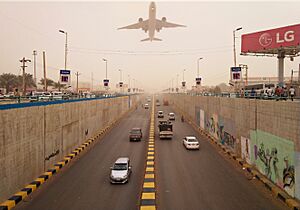
The Souq al Arabi is Khartoum's largest open air market. The souq is spread over several blocks in the center of Khartoum proper just south of the Great Mosque (Mesjid al-Kabir) and the minibus station. It is divided into separate sections, including one focused entirely on gold.
Al Qasr Street and Al Jamhoriyah Street are considered the most famous high streets in Khartoum State.
Afra Mall is located in the southern suburb of Arkeweet. The Afra Mall has a supermarket, retail outlets, coffee shops, a bowling alley, movie theaters, and a children's playground.
In 2011, Sudan opened the Hotel Section and part of the food court of the new, Corinthia Hotel Tower. The Mall/Shopping section is still under construction.
Education
Khartoum is the main location for most of Sudan's top educational bodies. There are four main levels of education:
- Kindergarten and day-care. It begins in the age of 3–4, consists of 1-2 grades, (depending on the parents).
- Elementary school. The first grade pupils enter at the age of 6–7. It consists of 8 grades, after which, at 13–14 years old, students are ready to take the certificate exams and enter high school.
- Upper second school and high school. In these three the school methods add some main academic subjects such as chemistry, biology, physics, and geography. There are three grades in this level. The students' ages are about 14–15 to 17–18.
- Higher education. There are several universities and colleges in Khartoum, including the University of Khartoum and Sudan University of Science and Technology.
Transportation
Khartoum is home to the largest airport in Sudan, Khartoum International Airport. It is the main hub for Sudan Airways, Sudan's main carrier. A new airport was planned for the southern outskirts of the city, but with Khartoum's rapid growth and consequent urban sprawl, the airport is still located in the heart of the city.
Khartoum's transportation is limited to the vehicular road system, with buses and personal vehicles comprising the main types of vehicles. As with many cities in the continent, parts of Khartoum are connected through privately owned buses.

Khartoum has a number of bridges across both tributaries of the Nile. The Mac Nimir Bridge, the Blue Nile Road & Railway Bridge, the Cooper Bridge (also known as the Armed Forces Bridge), and the Elmansheya Bridge span the Blue Nile, connecting Khartoum to Khartoum North. The Omdurman Bridge, the Victory Bridge, and the Al-Dabbasin Bridge span the White Nile, connecting Khartoum to Omdurman. The Tuti Bridge connects Tuti Island with Khartoum. Prior to the construction of the Tuti Bridge in 2008, residents of Tuti Island relied on water taxis to cross the Blue Nile into Khartoum.
Khartoum has rail lines from Wadi Halfa, Port Sudan on the Red Sea, and El Obeid. All are operated by Sudan Railways.
Architecture
The architecture of Khartoum reflects the city's history since the early 1820s and is marked by both native Sudanese, Turkish, British and modern buildings. In general, the architecture of Sudan reflects a wide diversity in its shapes, materials, and use.
Since independence, the people of Sudan have introduced new infrastructure and technology, which has led to new and innovative building concepts, ideas and construction techniques.
Culture
Museums
The largest museum in Sudan is the National Museum of Sudan. Founded in 1971, it contains works from different epochs of Sudanese history. Among the exhibits are two Egyptian temples of Buhen and Semna, originally built by Pharaoh Hatshepsut and Pharaoh Tuthmosis III, respectively, but relocated to Khartoum upon the flooding of Lake Nasser.
The Republican Palace Museum, opened in 2000, is located in the former Anglican All Saints' cathedral on Sharia al-Jama'a, next to the historical Presidential Palace.
The Ethnographic Museum is located on Sharia al-Jama'a, close to the Mac Nimir Bridge.
Botanical gardens
Khartoum is home to one of the oldest botanical gardens in Africa, National Botanical Garden in the Mogran district of the city.
Clubs
Khartoum is home to several clubs including the Blue Nile Sailing Club, social clubs such as the German Club, the Greek Club, as well as football clubs Al Khartoum SC and Al Ahli Khartoum.
Places of worship
The places of worship in Khartoum primarily consist of Muslim mosques. There are also Christian churches and temples: St. Matthew's Cathedral, Khartoum, Roman Catholic Archdiocese of Khartoum (Catholic Church), Sudan Interior Church (Baptist World Alliance), the Greek Orthodox Church of the Annunciation and Presbyterian Church in Sudan (World Communion of Reformed Churches).
See also
 In Spanish: Jartum para niños
In Spanish: Jartum para niños


